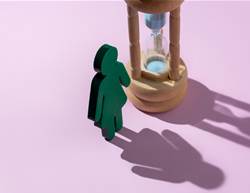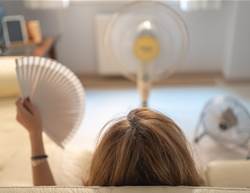Most of us pay an awful lot of attention to how our bodies look on the outside, without giving much thought to what’s holding them up – the complex 206-bone internal scaffolding that gives our frames structure and allows us freedom to move.
We often take this incredible skeleton of ours for granted, thinking it’ll always do what it’s always done, but bones are much more complex than that. Akin to living sponges with a hard lattice structure and hollow sections within, our bones are in a constant state of flux. Sometimes they’re building up (known as formation); other times they’re breaking down (known as resorption).
As we age and we lose the bone-building powerhouse oestrogen, formation slows down, making the hollow sections bigger. So, the density of our bones decreases, making them more fragile and at risk of injury. In fact, women can lose up to 20% of their bone density in the five to seven years after menopause.
By the age of 50, 66% of Australians have osteoporosis or osteopenia (poor bone health), reports Healthy Bones Australia.
“We think it’s a future issue and, yes, it is, but you need to catch it now,” says fitness expert Michelle Bridges, who’s launched a new 12-week program, The Menopause Method, offering nutrition advice and tailored workouts from some of Australia’s best menopause experts. “What we want to avoid is osteoporosis.”
Osteoporosis is the most severe case of bone loss. It’s also often referred to as a ‘silent disease’, as there are typically no symptoms until bone density is so low that fracturing a bone is a real risk. And it’s something Bridges is all too aware of.
“My mother has osteoporosis and arthritis. And she’s now unable to feel independent, and she’s quite fearful,” she says. “She’s very cautious now – and understandably so. What a shame. I often think if only we’d caught it earlier…”
Who’s at risk for osteoporosis?
Bridges wants conversations about menopause and bone health to be the norm, in the hopes of raising awareness and potentially being able to “hold back the tide a little, [in order]to be able to have a more independent future”.
With osteoporosis in her genetic pool, Bridges is at an increased risk of developing the condition herself. Other risk factors include if you
- have a thin build or have had an eating disorder
- entered menopause early
- take meds that cause bone loss;
- have inflammatory bowel disease, a thyroid issue, rheumatoid arthritis
- have a sedentary lifestyle
- drink excessive amounts of alcohol.
But bone loss can also be non-discriminatory.
“There isn’t anyone who shouldn’t be considering their bone health,” says Bridges, who is planning to have a bone density scan. Given her lifetime of adherence to fitness and a healthy diet, she stands a strong chance of being fine.
The good news is there are several ways we can help keep the skeleton strong, and regular weight-bearing exercise is front and centre.
Supporting bone health through exercise
“When you exercise, you put stress on your bones, which triggers a response inside your body to strengthen them,” explains Bridges. Specifically, it stimulates osteoblasts, specialised cells that support formation of new bone.
So, what constitutes weight-bearing exercise? Strength training or resistance training with weights is an obvious one. “Lift, push and pull heavy things and you’ll be bathing in the fountain of youth,” she says, adding, “it doesn’t have to be with weights, it can also be your own bodyweight – squats, push-ups, lunges.”
Yoga and Pilates are also great weight-bearing exercises, says Bridges – as is a simple stroll. “Walking is great; up a hill is even better. Walking up a set of stairs is fantastic, because you’re still getting some form of low-impact [exercise]. Go for a walk with a backpack on with some books in it? That’s a form of weight training. Walking outdoors in the sun for some vitamin D to help strengthen bones? Tick, tick, tick!”
Weight-bearing exercises are not only great for your bones, but for your muscle strength as well, Michelle says, “because then you’re turning your body from a two-stroke engine into a V8”.
While bones break more easily because of calcium loss, muscles lose mass and strength because of age-related loss, known as sarcopenia. By age 35 to 40, up to one per cent of muscle mass is lost yearly, with more rapid deterioration after age 65 for women and 70 for men. Because of a negative feedback loop, feeble muscles lead to frailer joints, cartilage tears and weaker bones.
By taking positive action now and adding regular weight-bearing exercise into your routine, you’ll improve your strength and coordination, and also maintain mobility. This means you’ll be less likely to fall and endure a sprain, fracture or break – and, if you do, you’ll recover sooner.
A diet for strong bones
Diet is a crucial component of maintaining bone strength. Michelle, who consulted with menopause dietitian Lisa Donaldson for the nutrition element of The Menopause Method, says the Mediterranean diet gets the universal tick of approval from experts as the ideal eating style to adopt.
The key is eating a balanced diet with foods rich in calcium, potassium, magnesium, phosphorus, vitamin D and vitamin K. To achieve this, think plentiful amounts of dairy, vegetables and wholegrains. Meanwhile, omega-3 fatty acids, found in oily fish and chia seeds, for example, have been found to not only reduce fracture risk, but directly impact bone mineral density, too.
“Proteins are also a really important factor because we want to maintain our muscle for as long as we can,” says Bridges.

Give your frame a boost with these bone-friendly foods
Capsicums: Vitamin C enhances production of natural collagen, which helps strengthen and harden bones. All colours are good, but yellow capsicums have the highest levels of this antioxidant.
Tomatoes: These vegie staples contain potassium, magnesium and phosphorus, which all aid in supporting bone density. Phosphorus helps form new bone cells and maintains pH balance to keep calcium from leaching out of bones.
Fortified yoghurt: Yoghurt delivers two major bone-health helpers, vitamin D and calcium, which are ideally consumed together for optimal absorption. Not all yoghurt has a useful amount of vitamin D, however, so look for brands that have been fortified with the nutrient.
Kale: Along with vitamin C, this dark leafy green contains vitamin K, which collaborates with calcium and phosphorus to form hydroxyapatite crystals – a contributor to strong bone density – and also plays a role in calcium absorption. Not a kale fan? Any dark, leafy greens are ideal to support bone health.
Water: Getting enough H2O supports a process whereby minerals work together to aid bone density and strength, while water also lubricates joints to minimise wear and tear.
Listen to Michelle Bridges speaking to Prevention Australia editor Zoe Meunier on the Thriving in Menopause podcast below.





.jpg&h=90&w=90&c=1&s=1)




.png&h=193&w=250&c=1&s=1)
.png&h=193&w=250&c=1&s=1)

